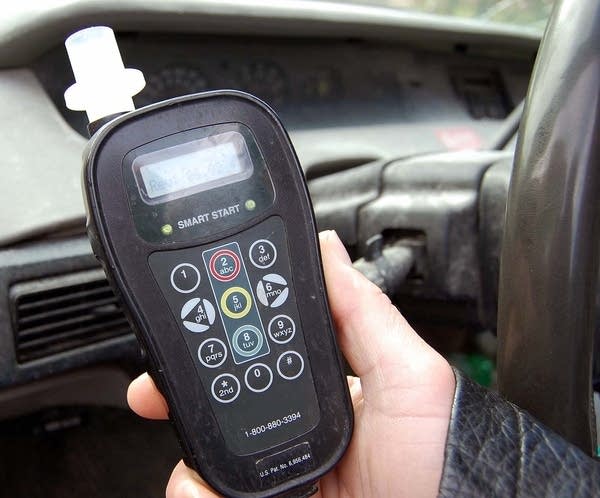More drunken driving offenders using ignition device

A small but growing number of drunken driving offenders in Minnesota are using an electronic device designed to keep them from reoffending, a program first piloted by the Minnesota Department of Public Safety in Hennepin and Beltrami counties and has now expanded statewide.
It's called ignition interlock, and it's a device that prevents drivers from starting their car if they've been drinking.
When Dietrich Drauden wants to start his car, he first needs to prove he's sober. The Bemidji-area resident lost his driver's license after his third DWI last year.
But Drauden was allowed to keep driving when he volunteered to use ignition interlock. It's installed beneath his steering wheel and is controlled by a hand-held device about the size of a desk phone.
Create a More Connected Minnesota
MPR News is your trusted resource for the news you need. With your support, MPR News brings accessible, courageous journalism and authentic conversation to everyone - free of paywalls and barriers. Your gift makes a difference.
The device instructs Drauden to blow and then hum into a small plastic tube so it can analyze his breath for alcohol.
"And then it analyzes and then it will say pass or fail, and that's it," Drauden said while demonstrating the device. "And then you can start your car."
Drauden said without his car, his life would be very complicated. He'd struggle getting to treatment and probation appointments and he'd have a hard time getting his kids to school activities. Drauden figures if he couldn't drive, he probably would have been fired from his job.

"For me, I don't live in town, so there's no public transportation," he said. "It is hard to get a ride to whatever construction site I'm working on. So there's no way around it; I have to drive."
Drauden is one of about 100 who participated in a limited pilot program in Beltrami and Hennepin counties. That number has tripled since the program went statewide in July.
National studies show that two-thirds of drunken driving offenders continue to drive even when their license is suspended. Sheila Fontaine supervises the ignition interlock program in Beltrami County. Fontaine said the device improves public safety while allowing offenders a chance to pull their lives together.
"Each of these people has found a sense of freedom here with being able to get behind the wheel and drive legally," Fontaine said. "And with this device on the vehicle, they can do it and they aren't going to repeat the behavior that got them here."
However, Fontaine said it hasn't been easy finding offenders willing to use ignition interlock. The biggest barrier may be the cost. Users are typically required to pay for the device themselves. That means monthly fees ranging from $75 to $125 dollars. That's a big deal in Beltrami and other counties with high poverty rates.

State officials have tweaked the program to create more incentive for offenders to sign on. Initially, interlock users were allowed to drive only to work, to AA meetings or probation appointments. Now, offenders with license suspensions as long as seven years can get back on the road and drive anywhere they want.
"At this point in time, we're saying after a period of hard revocation, very short, 15 to 30 days, you can get back on the road driving," said Jean Ryan, who oversees the program at the Minnesota Office of Traffic Safety.
Use of the device in Minnesota is still mostly voluntary, but some judges are using it as a probation tool. National studies have shown ignition interlocks have cut repeat drunken driving offenses by as much as 65 percent.
Emil Carlson-Clark, with the Hennepin County Probation Office, said it will take some time, but he predicts the device will become commonplace.
"The interlock is the wave of the future as far as a tool to help curb drunk driving," Carlson-Clark said. "I don't think it's the answer, but I think we've learned a lot in the last two years and I hope we learn a lot more in the next two years as it develops into a statewide program."
Minnesota is among the last states in the country to adopt ignition interlock. A federal transportation bill in Congress would compel all states to require the devices for every convicted drunken driver.
